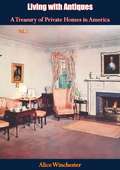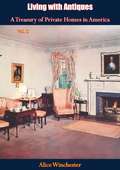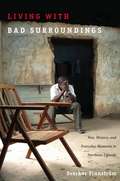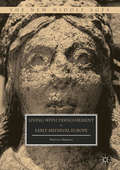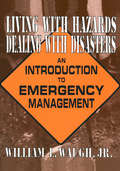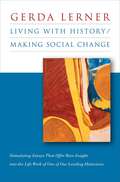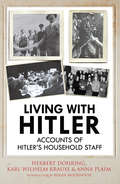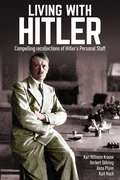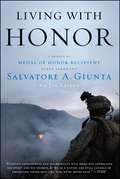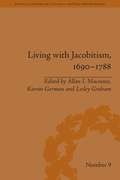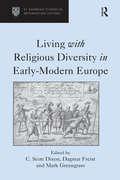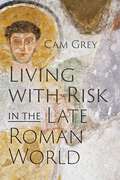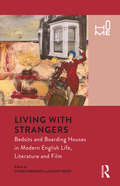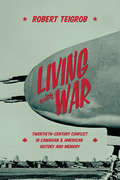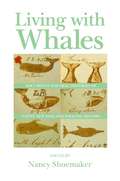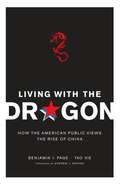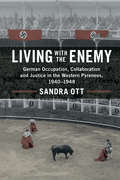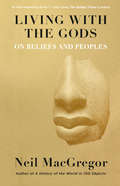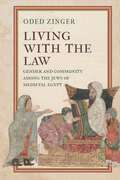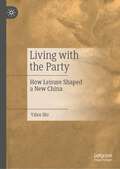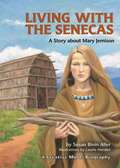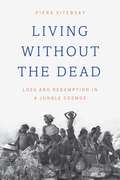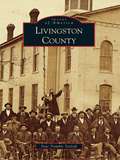- Table View
- List View
Living with Antiques: A Treasury of Private Homes in America Vol. I (Living with Antiques #1)
by Alice WinchesterIN THIS BOOK we have brought together treasures from the past and a wealth of ideas for their use and enjoyment in the present. Like The ANTIQUES Treasury of Furniture and Other Decorative Arts published in 1959, to which it is a companion, this volume is full of information about antiques, but while the previous volume concerned itself with the collections of seven great American museums, this is devoted to American private homes. It makes no recommendations as to what should be done, but it shows what has actually been done by some of America’s most discriminating collectors to bring beauty and also a sense of stability and continuity into their homes. For to these collectors living with antiques does not mean living in the past: it means preserving and enjoying the best of the past in order to add an extra dimension to the present.
Living with Antiques: A Treasury of Private Homes in America Vol. II (Living with Antiques #2)
by Alice WinchesterIN THIS BOOK we have brought together treasures from the past and a wealth of ideas for their use and enjoyment in the present. Like The ANTIQUES Treasury of Furniture and Other Decorative Arts published in 1959, to which it is a companion, this volume is full of information about antiques, but while the previous volume concerned itself with the collections of seven great American museums, this is devoted to American private homes. It makes no recommendations as to what should be done, but it shows what has actually been done by some of America’s most discriminating collectors to bring beauty and also a sense of stability and continuity into their homes. For to these collectors living with antiques does not mean living in the past: it means preserving and enjoying the best of the past in order to add an extra dimension to the present.
Living with Bad Surroundings: War, History, and Everyday Moments in Northern Uganda
by Sverker FinnströmSince 1986, the Acholi people of northern Uganda have lived in the crossfire of a violent civil war, with the Lord's Resistance Army and other groups fighting the Ugandan government. Acholi have been murdered, maimed, and driven into displacement. Thousands of children have been abducted and forced to fight. Many observers have perceived Acholiland and northern Uganda to be an exception in contemporary Uganda, which has been celebrated by the international community for its increased political stability and particularly for its fight against AIDS. These observers tend to portray the Acholi as war-prone, whether because of religious fanaticism or intractable ethnic hatreds. In Living with Bad Surroundings, Sverker Finnstrm rejects these characterizations and challenges other simplistic explanations for the violence in northern Uganda. Foregrounding the narratives of individual Acholi, Finnstrm enables those most affected by the ongoing "dirty war" to explain how they participate in, comprehend, survive, and even resist it. Finnstrm draws on fieldwork conducted in northern Uganda between 1997 and 2006 to describe how the Acholi--especially the younger generation, those born into the era of civil strife--understand and attempt to control their moral universe and material circumstances. Structuring his argument around indigenous metaphors and images, notably the Acholi concepts of good and bad surroundings, he vividly renders struggles in war and the related ills of impoverishment, sickness, and marginalization. In this rich ethnography, Finnstrm provides a clear-eyed assessment of the historical, cultural, and political underpinnings of the civil war while maintaining his focus on Acholi efforts to achieve "good surroundings," viable futures for themselves and their families.
Living with Disfigurement in Early Medieval Europe
by Patricia SkinnerThis book is open access under a CC-BY license. This book examines social and medical responses to the disfigured face in early medieval Europe, arguing that the study of head and facial injuries can offer a new contribution to the history of early medieval medicine and culture, as well as exploring the language of violence and social interactions. Despite the prevalence of warfare and conflict in early medieval society, and a veritable industry of medieval historians studying it, there has in fact been very little attention paid to the subject of head wounds and facial damage in the course of war and/or punitive justice. The impact of acquired disfigurement --for the individual, and for her or his family and community--is barely registered, and only recently has there been any attempt to explore the question of how damaged tissue and bone might be treated medically or surgically. In the wake of new work on disability and the emotions in the medieval period, this study documents how acquired disfigurement is recorded across different geographical and chronological contexts in the period. This book is open access under a CC-BY license.
Living with Hazards, Dealing with Disasters: An Introduction to Emergency Management
by William L WaughThis is the first concise introduction to emergency management, the emerging profession that deals with disasters from floods and earthquakes to terrorist attacks. Twenty case studies illustrate the handling of actual disasters including the Northridge Earthquake and the Oklahoma City Bombing. Discussion questions and guides to on-line information sources facilitate use of the book in the classroom and professional training programs.
Living with History / Making Social Change
by Gerda LernerThis stimulating collection of essays in an autobiographical framework spans the period from 1963 to the present. It encompasses Gerda Lerner's theoretical writing and her organizational work in transforming the history profession and in establishing Women's History as a mainstream field.Six of the twelve essays are new, written especially for this volume; the others have previously appeared in small journals or were originally presented as talks, and have been revised for this book. Several essays discuss feminist teaching and the problems of interpretation of autobiography and memoir for the reader and the historian. Lerner's reflections on feminism as a worldview, on the meaning of history writing, and on problems of aging lend this book unusual range and depth. Together, the essays illuminate how thought and action connected in Lerner's life, how the life she led before she became an academic affected the questions she addressed as a historian, and how the social and political struggles in which she engaged informed her thinking. Written in lucid, accessible prose, the essays will appeal to the general reader as well as to students at all levels. Living with History / Making Social Change offers rare insight into the life work of one of the leading historians of the United States.
Living with Hitler: Accounts of Hitlers Household Staff
by Karl Wilhelm Krause Herbert Döhring Anna PlaimThis collection paints a picture of Hitler from members of his household in the unique position of being seemingly ever-present, yet totally unconnected to events.The reader is introduced to Hitler's Bodyguard Karl Krause (1934-39), his house administrator Herbert Dhring (1935-43) and chambermaid Anna Plaim (1941-43). From these accounts we get a deeper sense of Hitler in close proximity.These accounts massively add to our understanding of Hitler as a three dimensional character, especially from subjects like Plaim who only knew Hitler's home life, having rarely left Berghof.The series is able to shed light on his likes and dislikes from foods to his hobbies, creating a strange sense of humanity. This collection also provides the reader with fresh anecdotes, observations and portraits of Hitler's entourage and relatives. Plaim's images of Eva Braun come from finding torn fragments in the bin, whilst Dhring sheds light on Martin Bormann's demeanour.
Living with Hitler: Compelling recollections of Hitler's Personal Staff
by Karl Wilhelm Krause Herbert Döhring Anna Plaim Kurt KuchThis collection paints a picture of Hitler from members of his household in the unique position of being &“seemingly ever-present, yet totally unconnected to events.&” Compelling recollections from Hitler's Bodyguard Karl Krause (1934-39), his house administrator Herbert Döhring (1935-43) and chambermaid Anna Plaim (1941-43). From these accounts we get a deeper sense of Hitler in close proximity. These accounts massively add to our understanding of Hitler as a three dimensional character, especially from subjects like Plaim who only knew Hitler's home life, having rarely left Berghof. The authors shed light on his likes and dislikes from foods to his hobbies, creating a strange sense of humanity. This collection also provides fresh anecdotes, observations and portraits of Hitler's entourage and relatives. Plaim's images of Eva Braun came from finding torn fragments in the bin, whilst Döhring sheds light on Martin Bormann's demeanour.
Living with Honor
by Joe Layden Sal GiuntaThere was the sound of a single bullet, and then . . . a deafening barrage of gunfire and explosions. There were, literally, thousands of bullets in the air at once, and more tracers streaking across the sky than there were stars overhead. It was a miracle that most of us weren't killed instantly. Staff Sergeant Salvatore, "Sal," Giunta was the first living person to receive the Medal of Honor--the highest honor presented by the U.S. military--since the conclusion of the Vietnam War. In Living with Honor, this hero who maintains he is "just a soldier" tells us the story of the fateful day in Afghanistan that led to his receiving the unique honor. With candor, insight, and humility, Giunta not only recounts the harrowing events leading up to when he and his company fell under siege, but also illustrates the empowering, invaluable lessons he learned. As a seventeen-year-old teen working at Subway, Giunta was like any other kid trying to figure out which step to take next with his life after graduating from high school. When Giunta walked into the local Army recruiting center in his hometown, he just wanted a free T-shirt. But when he walked out, his curiosity had been piqued and he enlisted in the Army. Deployed to Afghanistan, Giunta soon learned from the more seasoned soldiers how "different" this war was compared to others that America had fought. Stationed with the 173rd Airborne Brigade near the Afghanistan-Pakistan border in the Korengal Valley-- also known as the "Valley of Death"--Giunta and his company were ambushed by Taliban insurgents. Giunta went into action after seeing that his squad leader had fallen. Exposing himself to blistering enemy fire, Giunta charged toward his squad leader and administered first aid while he covered him with his own body. Though Giunta was struck by the relentless barrage of bullets, he engaged the enemy and then attempted to reach additional wounded soldiers. When he realized that yet another soldier was separated from his unit, he advanced forward. Discovering two rebels carrying away a U.S. soldier, Giunta killed one insurgent and wounded the other, and immediately provided aid to the injured soldier. More than just a remarkable memoir by a remarkable person, Living with Honor is a powerful testament to the human spirit and all that one can achieve when faced with seemingly impossible obstacles. *** The President clasps the medal around my neck. Applause fills the room. But I know it's not for me alone. I look at my mom and dad. I look at Brennan's parents and I look at Mendoza's. And I try to communicate to Brennan and Mendoza wordlessly: This is for you . . . and for everyone who has fought and died. For everyone who has made the ultimate sacrifice. I am not a hero. I'm just a soldier. --Salvatore A. Giunta, from Living with Honor
Living with Honor: A Memoir
by Joe Layden Salvatore GiuntaThere was the sound of a single bullet, and then . . . a deafening barrage of gunfire and explosions. There were, literally, thousands of bullets in the air at once, and more tracers streaking across the sky than there were stars overhead. It was a miracle that most of us weren't killed instantly. Staff Sergeant Salvatore, "Sal," Giunta was the first living person to receive the Medal of Honor--the highest honor presented by the U.S. military--since the conclusion of the Vietnam War. In Living with Honor, this hero who maintains he is "just a soldier" tells us the story of the fateful day in Afghanistan that led to his receiving the unique honor. With candor, insight, and humility, Giunta not only recounts the harrowing events leading up to when he and his company fell under siege, but also illustrates the empowering, invaluable lessons he learned. As a seventeen-year-old teen working at Subway, Giunta was like any other kid trying to figure out which step to take next with his life after graduating from high school. When Giunta walked into the local Army recruiting center in his hometown, he just wanted a free T-shirt. But when he walked out, his curiosity had been piqued and he enlisted in the Army. Deployed to Afghanistan, Giunta soon learned from the more seasoned soldiers how "different" this war was compared to others that America had fought. Stationed with the 173rd Airborne Brigade near the Afghanistan-Pakistan border in the Korengal Valley-- also known as the "Valley of Death"--Giunta and his company were ambushed by Taliban insurgents. Giunta went into action after seeing that his squad leader had fallen. Exposing himself to blistering enemy fire, Giunta charged toward his squad leader and administered first aid while he covered him with his own body. Though Giunta was struck by the relentless barrage of bullets, he engaged the enemy and then attempted to reach additional wounded soldiers. When he realized that yet another soldier was separated from his unit, he advanced forward. Discovering two rebels carrying away a U.S. soldier, Giunta killed one insurgent and wounded the other, and immediately provided aid to the injured soldier. More than just a remarkable memoir by a remarkable person, Living with Honor is a powerful testament to the human spirit and all that one can achieve when faced with seemingly impossible obstacles. *** The President clasps the medal around my neck. Applause fills the room. But I know it's not for me alone. I look at my mom and dad. I look at Brennan's parents and I look at Mendoza's. And I try to communicate to Brennan and Mendoza wordlessly: This is for you . . . and for everyone who has fought and died. For everyone who has made the ultimate sacrifice. I am not a hero. I'm just a soldier. --Salvatore A. Giunta, from Living with Honor
Living with Jacobitism, 1690–1788: The Three Kingdoms and Beyond (Political and Popular Culture in the Early Modern Period #9)
by Allan I. MacInnes Kieran German Lesley GrahamFor over seventy years after the ‘Glorious Revolution’ of 1688–90, Jacobitism survived in the face of Whig propaganda. These essays seek to challenge current views of Jacobite historiography. They focus on migrant communities, networking, smuggling, shipping, religious and intellectual support mechanisms, art, architecture and identity.
Living with Religious Diversity in Early-Modern Europe (St Andrews Studies in Reformation History)
by Dagmar FreistCurrent scholarship continues to emphasise both the importance and the sheer diversity of religious beliefs within early modern societies. Furthermore, it continues to show that, despite the wishes of secular and religious leaders, confessional uniformity was in many cases impossible to enforce. As the essays in this collection make clear, many people in Reformation Europe were forced to confront the reality of divided religious loyalties, and this raised issues such as the means of accommodating religious minorities who refused to conform and the methods of living in communion with those of different faiths. Drawing together a number of case studies from diverse parts of Europe, Living with Religious Diversity in Early Modern Europe explores the processes involved when groups of differing confessions had to live in close proximity - sometimes grudgingly, but often with a benign pragmatism that stood in opposition to the will of their rulers. By focussing on these themes, the volume bridges the gap between our understanding of the confessional developments as they were conceived as normative visions and religious culture at the level of implementation. The contributions thus measure the religious policies articulated by secular and ecclesiastical elites against the 'lived experience' of people going about their daily business. In doing this, the collection shows how people perceived and experienced the religious upheavals of the confessional age and how they were able to assimilate these changes within the framework of their lives.
Living with Risk in the Late Roman World (Critical Studies in Risk and Disaster)
by Cam GreyExplores the ever-present experiences of risk that characterized the daily existence of individuals, communities, and societies in the late Roman worldLiving with Risk in the Late Roman World explores the ever-present experiences of risk that characterized the daily existence of individuals, communities, and societies in the late Roman world (late third century CE through mid-sixth century CE). Recognizing the vital role of human agency, author Cam Grey bases his argument on the concept of the riskscape: the collection of risks that constitute everyday lived experience, the human perception of those risks, and the actions that exploit, mitigate, or exacerbate them. In contrast to recent grand narratives of the fate of the late Roman Empire, Living with Risk in the Late Roman World focuses on the quotidian practices of mitigation and management, foreknowledge and prediction, and mobilization and manipulation of risks at the individual and community levels.Grey illustrates the ubiquity of these practices through a collection of anecdotes that emphasize the highly localized, heterogeneous, and complementary nature of riskscapes: members of local communities enlisting figures of power to neutralize the hazards posed by imminent catastrophes, be it a tsunami, earthquake, or volcanic eruption; Christian holy figures both suffering and imposing bodily affliction as part of their claims to control such hazards and thereby to exercise influence in these communities; intimate experiences of seasonality and weather that shaped local practices of subsistence but also of self-representation; and geographically specific and fiercely contested claims to special knowledge and control of water.Multidisciplinary in its methodology and provocative in its argumentation, Living with Risk in the Late Roman World demonstrates that human communities in the ancient past were inextricably intertwined with the world around them, and that the actions they took simultaneously responded to and shaped the risks—both hazardous and favorable—that they perceived.
Living with Strangers: Bedsits and Boarding Houses in Modern English Life, Literature and Film (Home Ser.)
by Chiara BrigantiLiving with Strangers examines the history and cultural representation of bed-sitting rooms and boarding houses in England from the early twentieth century to the present. Providing a historical overview, the authors explore how these alternative domestic spaces came to provide shelter for a diverse demographic of working women and men, retired army officers, gay people, students, bohemians, writers, artists, performers, migrants and asylum seekers, as well as shady figures and criminals. Drawing on historical records, case studies, and examples from literature, art, and film, the book examines how the prevalence and significance of bedsits and boarding houses in novels, plays, detective stories, Ealing comedies, and contemporary fiction and film produced its own genre of narrative. The nine chapters are written by an international range of established and emerging scholars in the fields of literary studies, art and film history, political theory, queer studies and cultural studies. A lively, highly original study, Living with Strangers makes a significant contribution to the cross-disciplinary field of home studies and provides insight into a crucial aspect of British cultural history. It is essential reading for students and researchers in anthropology, history, literary studies, sociology, gender and sexuality studies, film studies and cultural studies.
Living with War: Twentieth-Century Conflict in Canadian and American History and Memory
by Robert TeigrobCanada and the United States: we think of one as a peaceable kingdom, the other as a warrior nation. But do our expectations about each country's attitudes to war and peace match the realities?In Living with War, Robert Teigrob examines how war is experienced and remembered on both sides of the 49th parallel. Surveying popular and scholarly histories, films and literature, public memorials, and museum exhibits in both countries, he comes to some startling conclusions. Americans may seem more patriotic, even jingoistic, but they are also more willing to debate the pros and cons of their military actions. Canadians, though more diffident in their public displays of patriotism, are more willing than their southern neighbors to accept the official narrative that depicts just wars fought in the service of a righteous cause.A provocative book that complements critiques of contemporary Canadian militarism such as Warrior Nation, Living with War offers an intriguing look at the relationship with the military past on both sides of the border.
Living with Whales: Documents and Oral Histories of Native New England Whaling History (Native Americans of the Northeast)
by Nancy Shoemaker<p>Native Americans along the coasts of southern New England and Long Island have had close ties to whales for thousands of years. They made a living from the sea and saw in the world's largest beings special power and meaning. After English settlement in the early seventeenth century, the region's natural bounty of these creatures drew Natives and colonists alike to develop whale hunting on an industrial scale. By the nineteenth century, New England dominated the world in whaling, and Native Americans contributed substantially to whaleship crews. <p>In Living with Whales, Nancy Shoemaker reconstructs the history of Native whaling in New England through a diversity of primary documents: explorers' descriptions of their "first encounters," indentures, deeds, merchants' accounts, Indian overseer reports, crew lists, memoirs, obituaries, and excerpts from journals kept by Native whalemen on their voyages. These materials span the centuries-long rise and fall of the American whalefishery and give insight into the far-reaching impact of whaling on Native North American communities. One chapter even follows a Pequot Native to New Zealand, where many of his Maori descendants still reside today. <p>Whaling has left behind a legacy of ambivalent emotions. In oral histories included in this volume, descendants of Wampanoag and Shinnecock whalemen reflect on how whales, whaling, and the ocean were vital to the survival of coastal Native communities in the Northeast, but at great cost to human life, family life, whales, and the ocean environment.</p>
Living with the Dragon: How the American Public Views the Rise of China (Contemporary Asia in the World)
by Tao Xie Benjamin PageIt is widely believed that most Americans not only distrust but also despise China. Considering the country's violent political history, unprecedented economic rise, and growing military capabilities, China has become America's strongest market competitor and arguably the most challenging global threat to the United States.Nevertheless, a full consideration of American opinion proves the opposite to be true. Carefully analyzing all available polls and surveys, Benjamin I. Page and Tao Xie find most Americans favor peaceful engagement with China. The public view has been surprisingly coherent and consistent, changing only in response to major events and new information. While a majority of Americans are not happy that China's economy is projected to become as large as that of the United States, they are prepared to live with it. "Unfair" Chinese trade practices and their impact on American jobs and wages are a concern, along with the quality and safety of Chinese-made goods. However, Americans favor free trade with China, provided it is tempered with environmental and workplace protections. They also believe that the United States should "balance" Chinese power through alliances with neighboring countries, such as Japan. Yet they oppose military action to defend Taiwan. Page and Xie examine these opinions in relation to facts about China and in light of current U.S. debates on diplomacy and policy.
Living with the Enemy: German Occupation, Collaboration and Justice in the Western Pyrenees, 1940–1948
by Sandra OttIn post-liberation France, the French courts judged the cases of more than one hundred thousand people accused of aiding and abetting the enemy during the Second World War. In this fascinating book, Sandra Ott uncovers the hidden history of collaboration in the Pyrenean borderlands of the Basques and the Barnais in southwestern France through nine stories of human folly, uncertainty, ambiguity, ambivalence, desire, vengeance, duplicity, greed, self-interest, opportunism and betrayal. Covering both the occupation and liberation periods, she reveals how the book's characters became involved with the occupiers for a variety of reasons, ranging from a desire to settle scores and to gain access to power, money and material rewards, to love, friendship, fear and desperation. These wartime lives and subsequent postwar reckonings provide us with a new lens through which to understand human behavior under the difficult conditions of occupation, and the subsequent search for retribution and justice.
Living with the Gods: On Beliefs and Peoples
by Neil MacGregorIn the same format as his best-selling books A History of the World in 100 Objects and Germany: Memories of a Nation--the acclaimed art historian now gives us a magnificent new book that explores the relationship between faith and society.Until fairly recently, religion as a major influence on the nature of individual societies around the world seemed to be on the wane. Now, far from being marginalized, the relationship between faith and society has moved to the center of politics and global conversation. Neil MacGregor's new book traces the ways in which different societies have understood and articulated their places in the cosmic scheme. It examines mankind's beliefs not from the perspective of institutional religions but according to how shared narratives have shaped societies--and what happens when different narratives run up against each other. As he did in A History of the World in 100 Objects and Germany: Memories of a Nation, MacGregor brilliantly combines objects, places, and ideas to examine and, ultimately, illuminate these pressing contemporary concerns.
Living with the Law: Gender and Community Among the Jews of Medieval Egypt (Jewish Culture and Contexts)
by Oded ZingerLiving with the Law explores the marital disputes of Jews in medieval Islamic Egypt (1000–1250), relating medieval gossip, marital woes, and the voices of men and women of a world long gone. Probing the rich documents of the Cairo Geniza, a unique repository of discarded paper discovered in a Cairo synagogue, the book recovers the life stories of Jewish women and men working through their marital problems at home, with their families, in the streets of old Cairo, and in Jewish and Muslim courts. Despite a voluminous literature on Jewish law, the everyday practice of Jewish courts has only recently begun to be investigated systematically. The experiences of those at a legal, social, and cultural disadvantage allow us to go beyond the image propagated by legal institutions and offer a view “from below” of Jewish communal life and Jewish law as it was lived.Examining the interactions between gender and law in medieval Jewish communities under Islamic rule, Oded Zinger considers how women experienced Jewish courts and the pressure they faced to relinquish their monetary rights. The tactics with which women countered this pressure—ranging from exploiting family ties to appealing to Muslim courts—expose the complex relationship between individual agency, gendered expectations, and communal authority. Zinger concludes that, more than money, education, or lineage, it was the maintenance of a supportive network of social relations with men that protected women at different stages of their lives.
Living with the Party: How Leisure Shaped a New China
by Yifan ShiThis book explores the subcultures, cultural trends and regulations of leisure and subcultures among young people in Beijing from 1949 to the 1980s. It complicates our understanding of the successes of the CCP and the nature of those successes—more a synergy or synthesis than victory over society or defeat. It argues that while the CCP aimed to direct the most private sphere in people’s everyday life (i.e., leisure), it did not achieve this goal by coercive means, but by appealing ways through organized leisure activities. This book suggests that although elements of youth subcultures can be observed throughout the Mao era, we should not treat them as a way of passive resistance. Instead, we must position these subcultures between different layers of the Party’s leisure regulation to examine what the CCP actually achieved. Many people who engaged in subcultures defied the blatant politicization of their leisure, some might have defied the process of collectivization, but few defied the process of institutionalization during which people did not find state intervention contradictory to their own way of pleasure-seeking. This book also suggests that instead of regarding the Deng Xiaoping era as a breakaway from Maoist interventionist rule, we need to see the historical continuity as revealed by the Party’s uninterrupted policy of leisure regulation. Thought provoking and at times amusing, this book will interest sinologists, historians, and scholars of China's social form.
Living with the Senecas: A Story about Mary Jemison
by Susan Bivin AllerMary Jemison endured many hardships, dangers, and tragedies during her life. She was born in 1743 as her parents emigrated from Ireland to Pennsylvania. When she was fifteen years old, a group of raiding Shawnee Indians and French soldiers captured her and her family. She was the only one to survive. For seventy-five years, she lived among the Seneca Indians who adopted her. She outlived two husbands and bore eight children. She witnessed two wars and a revolution. Even though she could have returned to the white world, she chose to remain with the Senecas and became a loyal and respected member of her tribe.
Living without the Dead: Loss and Redemption in a Jungle Cosmos
by Piers VitebskyJust one generation ago, the Sora tribe in India lived in a world populated by the spirits of their dead, who spoke to them through shamans in trance. Every day, they negotiated their wellbeing in heated arguments or in quiet reflections on their feelings of love, anger, and guilt. Today, young Sora are rejecting the worldview of their ancestors and switching their allegiance to warring sects of fundamentalist Christianity or Hinduism. Communion with ancestors is banned as sacred sites are demolished, female shamans are replaced by male priests, and debate with the dead gives way to prayer to gods. For some, this shift means liberation from jungle spirits through literacy, employment, and democratic politics; others despair for fear of being forgotten after death. How can a society abandon one understanding of reality so suddenly and see the world in a totally different way? Over forty years, anthropologist Piers Vitebsky has shared the lives of shamans, pastors, ancestors, gods, policemen, missionaries, and alphabet worshippers, seeking explanations from social theory, psychoanalysis, and theology. Living without the Dead lays bare today’s crisis of indigenous religions and shows how historical reform can bring new fulfillments—but also new torments and uncertainties. Vitebsky explores the loss of the Sora tradition as one for greater humanity: just as we have been losing our wildernesses, so we have been losing a diverse range of cultural and spiritual possibilities, tribe by tribe. From the award-winning author of The Reindeer People, this is a heartbreaking story of cultural change and the extinction of an irreplaceable world, even while new religious forms come into being to take its place.
Living-Room War
by Michael J. ArlenThis book attempts to figure out exactly what television does to us. This collection of essays provides a poetic look at 1960s television culture, ranging from Vietnam War to Captain Kangaroo, from 1968 Democratic convention to televised sports.
Livingston County
by Faye Tramble TeitloffOn December 13, 1798, the Kentucky General Assembly enacted legislation authorizing the formation of Livingston County, named for Robert R. Livingston of New York, who helped draft the Declaration of Independence. The year 1811 brought the invention of the steamboat, which created transportation and passenger trade up and down the Cumberland and Ohio Rivers. Solidifying Livingston County's importance as a river port and stop-off for travelers, steamboats also brought their share of interesting characters to town. The stories and pictures still remain today, as tales of the Ford's Ferry Gang, the Horrible Harpes, and the murder of a local slave--killed by a relative of Thomas Jefferson--are just a few of the fascinating accounts included in this book.
